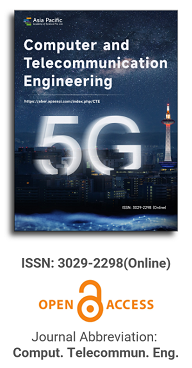
Analysis of the effectiveness of object coordinates estimation in WSN using the RSS method
Vol 2, Issue 1, 2024
Download PDF
Abstract
The methods of estimating the coordinates of sensor nodes based on the measurements made at the “anchor” nodes are widely used in WSNs. In particular, such methods include the RSS method, which is based on measuring the power of signals coming from sensors. The article shows that a similar method can be used for estimating the coordinates of an observation object in the WSN. The efficiency of measuring the coordinates of such an object in the presence of power measurement errors is analyzed. The conditions for increasing this efficiency have been identified. It is shown that the estimation is biased, but the magnitude of the bias is practically independent of the observational conditions and, therefore, can be easily compensated.
Keywords
References
- Sharma R. Advanced wireless sensor networks. In: Chapter in book Emerging computing paradigms: Principles, advanced and applications. Wiley Data and Cybersecurity; 2022. pp. 177-191.
- Kwasinski A, Chande V. Recent applications and emerging designs in source-channel coding. In: Chapter in book Joint source-channel coding. Wiley-IEEE Press; 2022. pp. 335-379.
- Khanna A, Kaur S. Internet of Things (IoT), Applications and Challenges: A Comprehensive Review. Wireless Personal Communications. 2020; 114(2): 1687-1762. doi: 10.1007/s11277-020-07446-4
- Liu Y, Yang Z. Location, Localization, and Localizability. Springer New York; 2011. doi: 10.1007/978-1-4419-7371-9
- Zekavat SAR. Handbook of Position Location: Theory, Practice, and Advances. IEEE Press-Wiley; 2011.
- Faragher R, Harle R. Location Fingerprinting with Bluetooth Low Energy Beacons. IEEE Journal on Selected Areas in Communications. 2015; 33(11): 2418-2428. doi: 10.1109/jsac.2015.2430281
- Win MZ, Shen Y, Dai W. A Theoretical Foundation of Network Localization and Navigation. Proceedings of the IEEE. 2018; 106(7): 1136-1165. doi: 10.1109/jproc.2018.2844553
- Zhai D, Lin Z. RSS-based indoor positioning with biased estimator and local geographical factor. 2015 22nd International Conference on Telecommunications (ICT). Published online April 2015. doi: 10.1109/ict.2015.7124718
- Lin M, Wang W, Liu C. Preventing Hostile TOA/TDOA Localization with AF Relay. IEEE Communications Letters. 2023; 27(4): 1085-1089. doi: 10.1109/lcomm.2023.3247871
- Wang Y, Ho KC. TDOA Positioning Irrespective of Source Range. IEEE Transactions on Signal Processing. 2017; 65(6): 1447-1460. doi: 10.1109/tsp.2016.2630030
- Wu P, Su S, Zuo Z, et al. Time Difference of Arrival (TDoA) Localization Combining Weighted Least Squares and Firefly Algorithm. Sensors. 2019; 19(11): 2554. doi: 10.3390/s19112554
- Zuo P, Peng T, Wu H, et al. Directional source localization based on RSS-AOA combined measurements. China Communications. 2020; 17(11): 181-193. doi: 10.23919/jcc.2020.11.015
- Nguyen NH, Dogancay K, Kuruoglu EE. An Iteratively Reweighted Instrumental-Variable Estimator for Robust 3-D AOA Localization in Impulsive Noise. IEEE Transactions on Signal Processing. 2019; 67(18): 4795-4808. doi: 10.1109/tsp.2019.2931210
- Li X. RSS-Based Location Estimation with Unknown Pathloss Model. IEEE Transactions on Wireless Communications. 2006; 5(12): 3626-3633. doi: 10.1109/twc.2006.256985
- Niu R, Vempaty A, Varshney PK. Received-Signal-Strength-Based Localization in Wireless Sensor Networks. Proceedings of the IEEE. 2018; 106(7): 1166-1182. doi: 10.1109/jproc.2018.2828858
- Peng T, Zuo P, You K, et al. Bounds and Methods for Multiple Directional Sources Localization Based on RSS Measurements. IEEE Access. 2019; 7: 131395-131406. doi: 10.1109/access.2019.2940650
- Pflaum F, Erhardt S, Weigel R, et al. RSSI-based localization with minimal infrastructure using multivariate statistic techniques. In Proc. of IEEE Topical Conference on Wireless Sensors and Sensor Networks; 2017: 69-72. doi: 10.1109/ECAI.2018.8679093
- Gezici S. A Survey on Wireless Position Estimation. Wireless Personal Communications. 2007; 44(3): 263-282. doi: 10.1007/s11277-007-9375-z
- Dargie W, Poellabauer C. Fundamentals of wireless sensor networks: Theory and practice. Wiley & Sons; 2010.
- Hernandez-Perez E, Navarro-Mesa JL, Martin-Gonzales S, et al. Path loss factor estimation for RSS-based localization algorithms with wireless sensor networks. In: 19th European Signal Processing Conference (EUSIPCO 2011). Barcelona, Spain; 2011. pp. 1994-1998.
- Babu RS, Suganthi M. Review of energy detection for spectrum sensing in various channels and its performance for cognitive radio applications. American Journal of Engineering and Applied Sciences. 2012; 5(2): 151-156. doi: 10.3844/ajeassp.2012.151.156
- Kostylev VI. Energy detection of a signal with random amplitude. In: IEEE International Conference on Communications. Conference Proceedings; 2002. pp. 1606-1610.
- Bhat BR. Modern Probability Theory. New Academic Science; 2019.
- Choi H., Jin H., Kim S.C. RSS bias compensation in BLE beacon based positioning system. In: 2017 Ninth International Conference on Ubiquitous and Future Networks (ICUFN).
- Parfenov VI, Le VD. Optimal fusion rule for distributed detection with channel errors taking into account sensors’ unreliability probability when protecting coastlines. International Journal of Sensor Networks. 2022; 38(2): 71-84. doi: 10.1504/IJSNET.2022.121157
Supporting Agencies
Copyright (c) 2024 Vladimir Ivanovich Parfenov
License URL: https://creativecommons.org/licenses/by/4.0

Prof. Maode Ma
Qatar University, Qatar
The field of computer and telecommunications engineering is rapidly advancing, with the following being some of the latest developments.
more
We are pleased to congratulate the first anniversiry of the journal of Computer and Telecommunication Engineering (CTE).
more
Owing to the tireless dedication of the editor-in-chief, editorial board members, and the in-house editorial team, we are proud to announce the successful online launch of the first issue of Computer and Telecommunication Engineering.
Asia Pacific Academy of Science Pte. Ltd. (APACSCI) specializes in international journal publishing. APACSCI adopts the open access publishing model and provides an important communication bridge for academic groups whose interest fields include engineering, technology, medicine, computer, mathematics, agriculture and forestry, and environment.


.jpg)

.jpg)
